CURRENT AFFAIRS
Get the most updated and recent current affair content on Padhaikaro.com
Yemen’s Houthi rebels agree to stop using child soldiers
- IAS NEXT, Lucknow
- 21, Apr 2022

Reference News:-
Yemen’s Houthi rebels have agreed to rid their ranks of child soldiers, who have fought by the thousands during the country’s seven years of civil war.
- The Houthis signed an “action plan” to end and prevent recruiting or using children in armed conflict, killing or maiming children and attacking schools and hospitals.
- The rebels have committed to identifying children in their ranks and releasing them within six months.
- More than 10,200 children have been killed or maimed in the war.
The recruitment and use of children as soldiers is one of the six U.N.-defined violations affecting children in times of war. The list also includes: the killing and maiming of children, sexual violence against children, child abductions, attacks against schools or hospitals and the denial of humanitarian access for children.
What led to this?
- Yemen’s civil war erupted in 2014 when the Iran-backed Houthis seized Sanaa and forced the government into exile. A Saudi-led coalition, including the United Arab Emirates, entered the war in early 2015 to try to restore the government to power.
- War monitors estimate the conflict has killed over 14,500 civilians and 150,000 people when combatants are included. The fighting also created one of the world’s worst humanitarian crises.
The warring sides agreed earlier this month to the first nationwide truce in six years.
Who are Houthis?
- The Houthis are Zaydi Shiites, or Zaydiyyah. Shiite Muslims are the minority community in the Islamic world and Zaydis are a minority of Shiites, significantly different in doctrine and beliefs from the Shiites who dominate in Iran, Iraq, and elsewhere (often called Twelvers for their belief in twelve Imams).
- The American invasion of Iraq in 2003 deeply radicalized the Houthi movement. The Houthis adopted the slogan: “God is great, death to the U.S., death to Israel, curse the Jews, and victory for Islam,” in the wake of the U.S.-led invasion of Iraq.
Yemen:
- Yemen is at the southern end of the Arabian Peninsula and borders Saudi Arabia and Oman.
- It has been in existence as a state in its current form since the early 1990s.
- Yemen is only 30km from Djibouti in Africa, which sits across the Bab al Mandab straits, which means Gate of Tears.
- Up to 18 million years ago, Yemen and the Horn of Africa were a single landmass. However, the Gulf of Aden’s rifting separated the Arabian Peninsula and the Horn region.
- Sanaʽa is the largest city in Yemen. Constitutionally, Sanaʽa is the capital of Yemen.
- Sanaʽa is a UNESCO World Heritage Site. It has a distinctive architectural character, most notably expressed in its multi-storey buildings decorated with geometric patterns.
- In the aftermath of the Houthi occupation, the capital moved to Aden – the former capital of South Yemen. Aden is located next to the Sarawat Mountains of Jabal An-Nabi Shu’ayb and Jabal Tiyal, considered to be the highest mountains in the country and amongst the highest in the region.